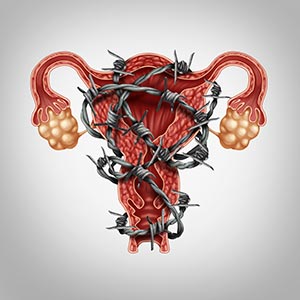Endometriosis
 A cause of female infertility, is a condition in which endometrial tissue, the tissue that lines the inside of the uterus, grows outside the uterus and attaches to other organs in the abdominal cavity such as the ovaries and fallopian tubes.
A cause of female infertility, is a condition in which endometrial tissue, the tissue that lines the inside of the uterus, grows outside the uterus and attaches to other organs in the abdominal cavity such as the ovaries and fallopian tubes.
Endometriosis is a progressive disease that tends to get worse over time and can reoccur after treatment. Symptoms include painful menstrual periods, abnormal menstrual bleeding and pain during or after sexual intercourse. The endometrial tissue outside your uterus responds to your menstrual cycle hormones the same way the tissue inside your uterus responds - it swells and thickens, then sheds to mark the beginning of the next cycle. The blood that is shed from the endometrial tissue in your abdominal cavity has no place to go, resulting in pools of blood causing an inflammation that forms scar tissue. The scar tissue can block the fallopian tubes or interfere with ovulation.
Another result of endometriosis is the formation of ovarian cysts called endometrioma that may also interfere with ovulation.
The cause of endometriosis is unknown though there are a few theories that suggest possible causes. One theory suggests that during menstruation, some of the menstrual tissue backs up through the fallopian tubes into the abdomen where it implants and grows. Another theory indicates that it is a genetic birth abnormality in which endometrial cells develop outside the uterus during fetal development.
A laparoscopy, an outpatient surgical procedure, is necessary to confirm a diagnosis of endometriosis after a medical history review and pelvic exam. After the initial diagnosis, your physician will classify your condition as stage 1 (minimal), stage 2 (mild), stage 3 (moderate) or stage 4 (extensive) based on the amount of scarring and diseased tissue found. Based on the stage of endometriosis, your physician will determine the best treatment plan for you which may include medication or surgery, or a combination of both.